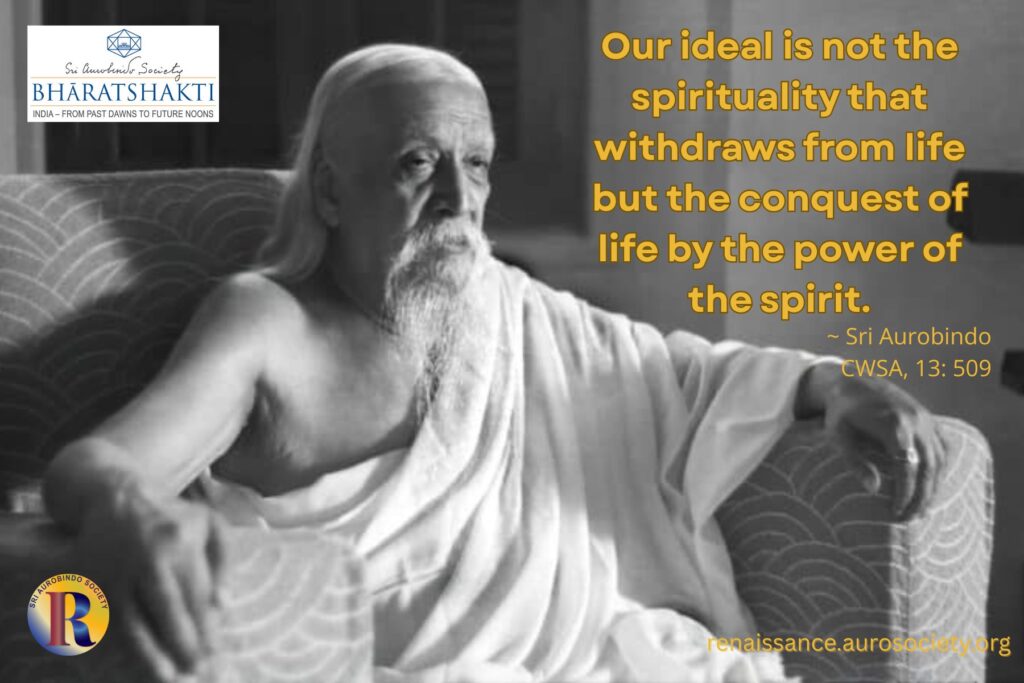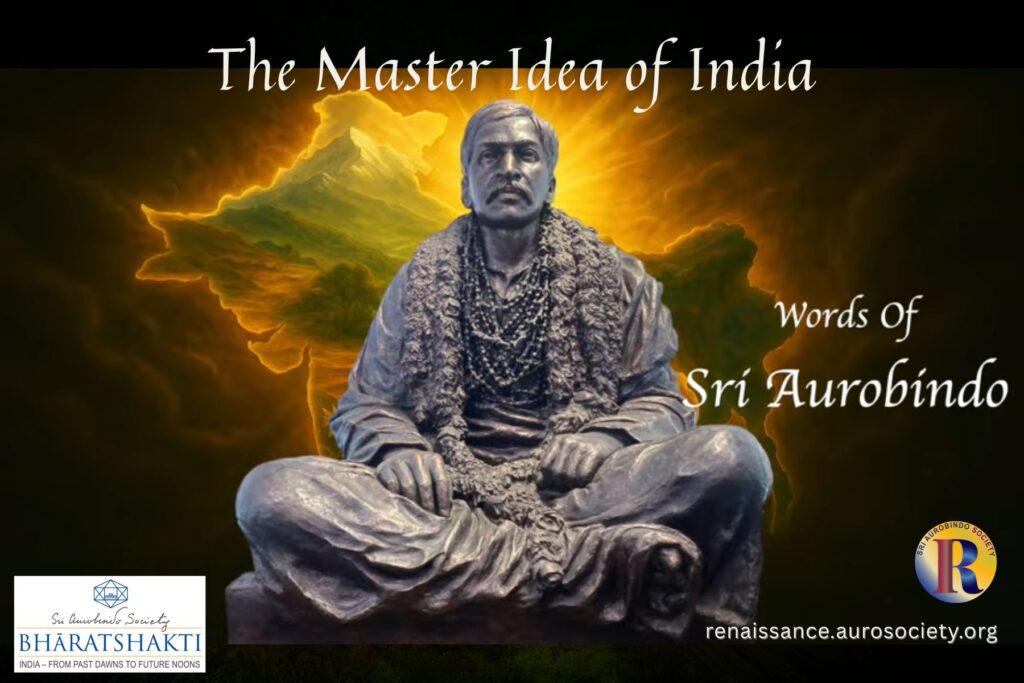Volume V, Issue 3
Author: Beloo Mehra
Who can forget these marvellous lines from Sri Aurobindo’s poem, Who?
The hand that sent Jupiter spinning through heaven,
~ Sri Aurobindo, CWSA, Vol. 2, p. 202
Spends all its cunning to fashion a curl.
The entire poem is a super-delight for every part of my being, every single time I read it. But it is these two lines that are always a bit extra special because they are simply so… endearing! Yes, that’s the word.
Sri Aurobindo, the seer-poet, the kavi, the rishi of the mantra that is Savitri, in these two simple lines reminds, through such lovable and charming an image, that the Divine is not somewhere far away. He or She or That is right here — with you, in you, in fact it is Divine’s Hand only which is fashioning that unruly curl of yours!
Lest we forget, it is the same Hand that also fashioned Jupiter and makes its spinning possible! So yes, the Supreme Divine has all the eternity. To create and sustain all the universes. And it uses the same eternity when it works behind that hand of yours which is struggling with curling iron!
But we generally forget both these truths, of the Divine Transcendent and the Divine Immanent. And we go about our day in forgetfulness. In our ignorance and on this plane of Ignorance, we get sucked in by the minutiae of mind, life and matter. And the only time we ever think of God is when we decide to step away from the demands of these three to connect with that Supreme Entity.
However, that is a God removed from everything else – though in truth That can never be removed for there is nothing but That, – one whom we picture sitting far away somewhere with whom we seek to make a contact, away from the chaos of the world. Our rishis and yogis have seen and spoken of That Transcendent Divine – one above the Manifestation.
But they have also sang of the Universal Divine who is present in the entire Manifestation. Of the One who is not separate from it all, who is the Lord and Master of the whole Cosmos. And they have also realized the truth of the Individual Divine. Of the One who is seated in each and every creature, every particle of all that is in the triple world of Ignorance.
Ishá vásyam idam sarvam yat kincha jagatyám jagat
For habitation by the Lord is all this, everything whatsoever that is moving thing in her that moves.
~ Isha Upanishad, 1 (translation by Sri Aurobindo)
So it is no miracle — or may be everything is a miracle — that the same Supreme who ensures the movement of all the planets is also in you and me when we brush our hair or cook in the kitchen.
It is in the flower as it blooms or withers away; in the pattern and fragrance of the flower. It is in the tree, in the seed which becomes the tree. And in the ether in which both the tree and seed are. In the words I type, in the words I delete, and in the inspiration from where these words come. Also in the spaces between the letters and words, and in the silences that will not be expressed through words. The term for this Supreme It or That, given to us, by our sages and seers is Brahman.
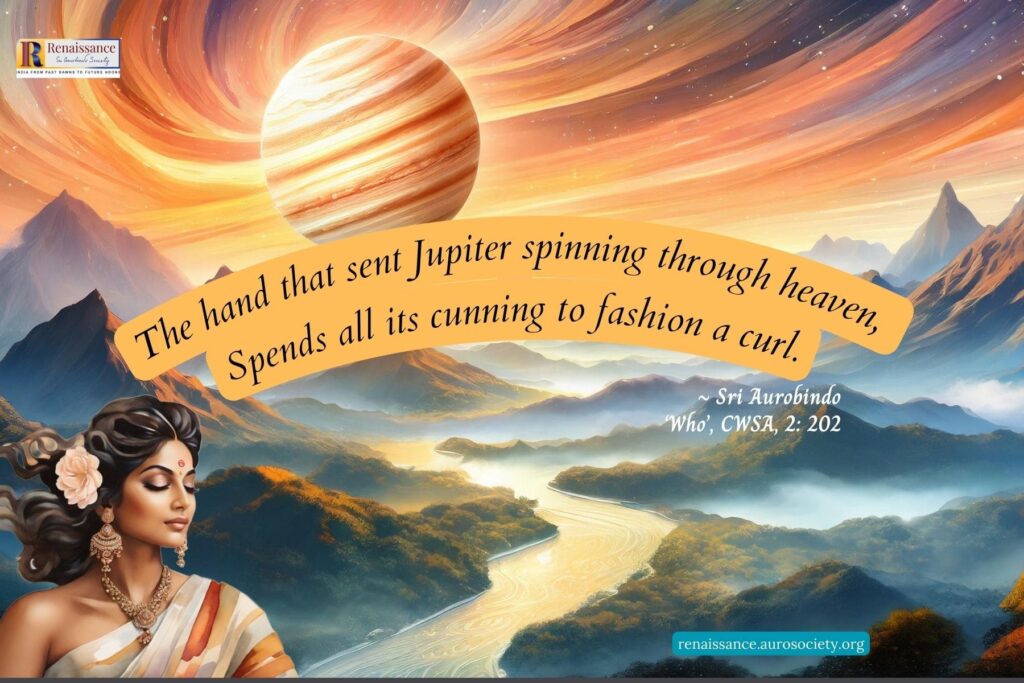
The Brahman Alone Is
The Brahman alone is, and because of It all are. For all are the Brahman, says the spiritual vision of India.
This Supreme Reality is the reality of everything that we see in Self and Nature, reminds Sri Aurobindo. All Manifestation is in Brahman alone. Brahman is the Absolute, the Transcendent and incommunicable; and also the Supracosmic Existence that sustains the cosmos. Brahman is the Absolute which takes all relativities in its embrace. Quoting the Upanishadic wisdom he writes in poetic prose:
Brahman is the Consciousness that knows itself in all that exists; Brahman is the Force that sustains the power of God and Titan and Demon, the Force that acts in man and animal and the forms and energies of Nature; Brahman is the Ananda, the secret Bliss of existence which is the ether of our being and without which none could breathe or live. Brahman is the inner Soul in all; it has taken a form in correspondence with each created form which it inhabits.
The Upanishads affirm that all this is the Brahman; Mind is Brahman, Life is Brahman, Matter is Brahman; addressing Vayu, the Lord of Air, of Life, it is said “O Vayu, thou art manifest Brahman”; and, pointing to man and beast and bird and insect, each separately is identified with the One,—“O Brahman, thou art this old man and boy and girl, this bird, this insect.”
The Lord of Beings is that which is conscious in the conscious being, but he is also the Conscious in inconscient things, the One who is master and in control of the many that are passive in the hands of Force Nature. He is the Timeless and Time; He is Space and all that is in Space; He is Causality and the cause and the effect: He is the thinker and his thought, the warrior and his courage, the gambler and his dice-throw.
Brahman, the Ishwara, in his self-manifestation, by the power of his Consciousness-Force — also known as Yoga-Maya,– becomes all that is, the jagati. He is the Conscious Being, Soul, Spirit, Purusha. And it is by his Nature, Prakriti, the force of his conscious self-existence that he is all things. He is the Isha, the omniscient and omnipotent All-ruler. And it is by his Shakti, his conscious Power, that he manifests himself in Time and governs the universe. The same power is called Prakriti when it is seen in its executive aspect as working out the manifestation for the Purusha or Ishwara.
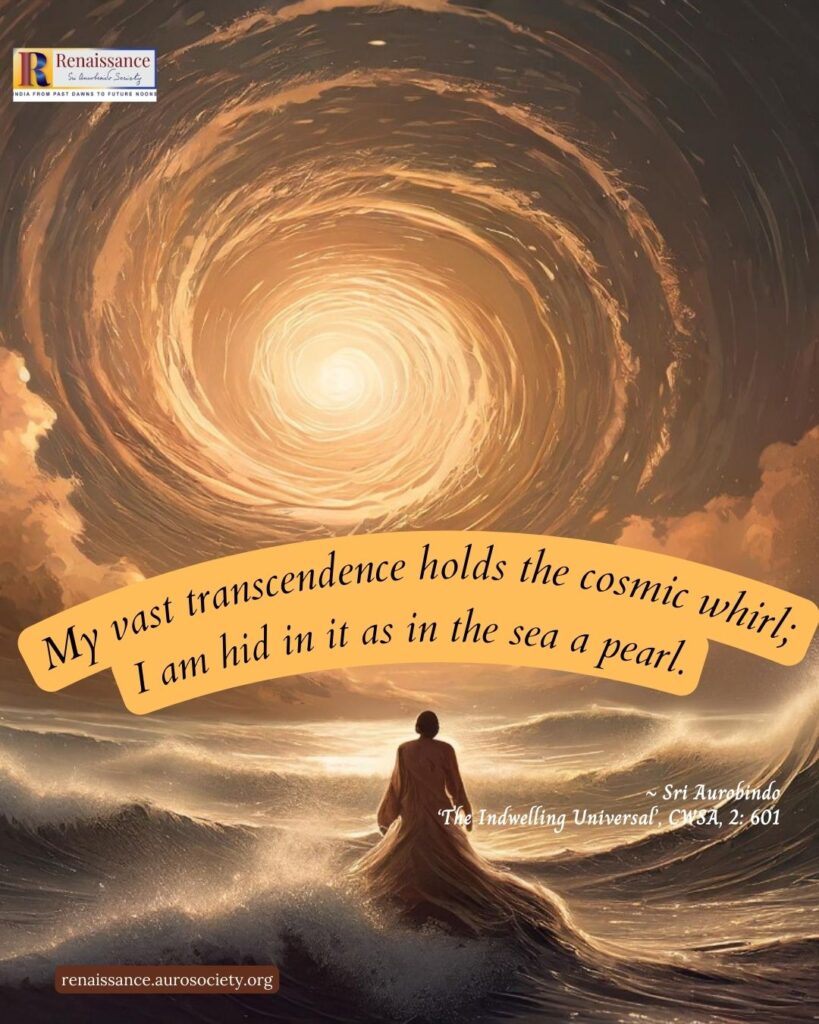
Of God and Nature
The absolute Brahman manifests as the Ishwara, the one Eternal. It also manifests as the multiplicity of the One in the Jiva, the living creature. Thus creating the double aspect of Being and Becoming. What we call as the soul or psychic entity in the individual is an eternal portion of Brahman, the Ishwara. But what of the other parts in an individual which move, act, and grow in the plane of Ignorance? What of the world movements, the affairs of our lives and the struggles and conflicts therein? If all these are workings of the Nature, of which our human nature is an intrinsic aspect, what is the relation of Ishwara with the Nature? Sri Aurobindo explains,
Being turns into becoming and yet it is always itself and other than its becomings; the Universal individualises itself and the Individual universalises himself; Brahman is at once void of qualities and capable of infinite qualities, the Lord and Doer of works, yet a non-doer and a silent witness of the workings of Nature.
~ CWSA, Vol. 21, pp. 340-341
WATCH
Sri Aurobindo regards man as not only made in the image of God, but made to manifest God.
It is true our oh-too-human nature, at present, is limited and tortured by inner and outer conflicts. But it is intrinsically divine because it is derived from the Super-Nature or Para-Prakriti and can be transformed into it. In Sri Aurobindo’s integral vision of life and existence, earthly life is the only field in the created universe where man can not only realise but also reveal God integrally. This is why we must never condemn earth or spurn earthly life.
And this is also why we do not find in Sri Aurobindo’s and the Mother’s teachings any disdain of human nature on the basis of some mistaken idea that human nature is like dog’s tail and hence irremediable. Rather the emphasis is on the full development of the nature to its utmost perfection so that it can be gradually refined and transformed into what it is meant to be — a true instrument of the Divine for fulfilling His Will and purpose in the world.
Following such an integral approach to human development can help heal the chasm that has been created in modern psyche regarding Man and Nature, Nature and God, and Man and God. With a growing awareness of the workings of Nature — e.g. the triguna prakriti of sattva, rajas and tamas — within one’s own nature — and the gradual conquering of the interplay of their movements, an individual becomes a real master of Nature in the truest sense of the term.
This is what makes it a stream of sadhana, an inner path to gradually conquering and transforming one’s nature. And this sadhana also includes an aspiration to arrive at a deeper harmony with all Nature, and through that with Existence, with the Divine in Nature.
Two Issues on ‘Divine in Nature’
The offerings in the current issue and the one coming up next month will help us explore some of these aspects. For our Guiding Light feature in the current issue, we highlight some deeply evocative passages from Sri Aurobindo. Titled God at the Beginning, God in the Middle, God at the End, God Everywhere, this feature also reminds us of a few key fundamentals of the Integral Vision of Sri Aurobindo, particularly that the Universe is a gradual unfolding or a progressive manifestation of the Truth, that is One Supreme. And “all that is is the manifestation of a Divine Infinite.”
Sri Aurobindo reminds us that Nature is only phenomenally Nature, but in reality she is God. Our ordinary human nature is also part of that same Nature. What is the relation between the hidden Divine Essence in our nature and the evolutionary inner journey that is called Yoga when pursued consciously? The feature titled From Nature to Supernature helps us reflect on this.
Vāsudevaḥ sarvam iti and Karmayoga brings two passages from Sri Aurobindo’s writings that help us deepen our understanding of the phrase वासुदेवः सर्वमिति from the Bhagavad Gita (7.19). One passage is from Essays on the Gita, and other from his commentaries on Isha Upanishad where he connects the idea, “The Lord is everywhere; the Lord surrounds everything with His presence; the Lord is all” with the practice of Karmayoga.
On February 29, 2024 we celebrated the anniversary of Supramental Manifestation of February 29, 1956. With the descent of this New Consciousness what is the work of the Nature? The Mother in her 1958 New Year message spoke of Nature’s consent to collaborate in bringing forth a New Creation. Nature, a Collaborator of the New Consciousness features the Mother’s explanation of this message. Also enjoy a small video featuring this special message of January 1, 1958.
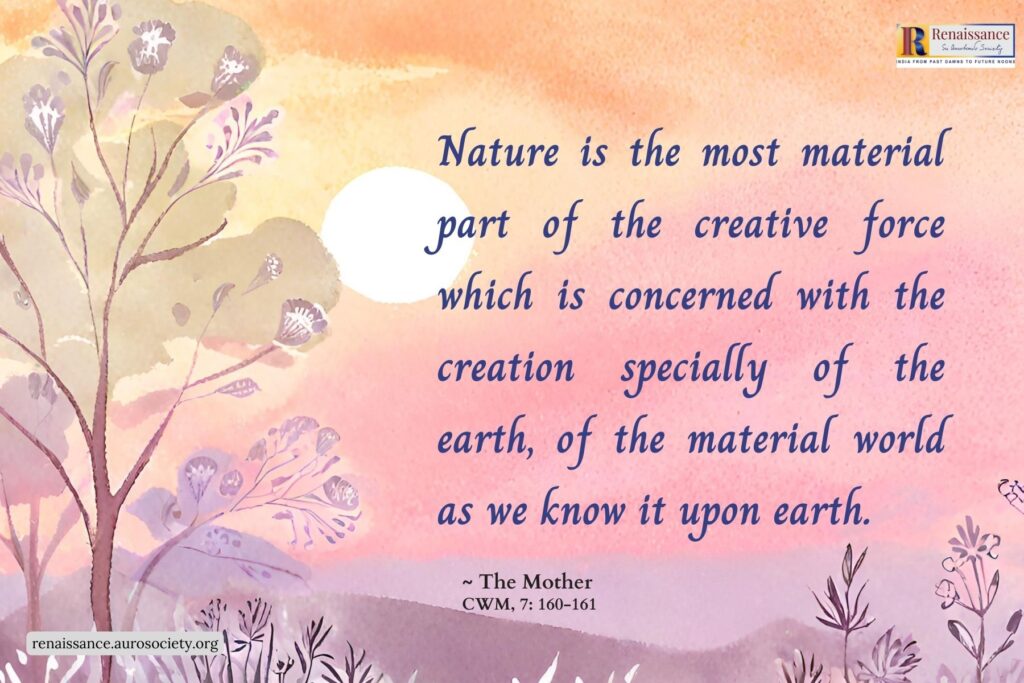
One aspect of the ‘Divine in Nature’ theme that we wish to especially emphasize concerns Flowers. In some of our previous issues we have featured several writings that speak of the Mother’s intimate connection with flowers, plants, trees and everything in Nature (read HERE, HERE, and HERE). In the current issue, we highlight a few conversations of the Mother in which she focuses on the Beauty aspect of the Divine that is expressed through flowers and all Nature.
The featured titled “In Nature one can live in beauty, always” also highlights the subtler aspects of Mother’s connection with the flowers, namely, their fragrance. She says that fragrance was one of the ways she identified with the vibration of the flower.
In the Playhouse of Infinite Forms is the contribution this month by Narendra Murty. From Guru Nanak to William Blake and Kahlil Gibran, from Tagore to Sri Aurobindo — this article invites you to immerse yourself in the beautiful poetic expressions of the Immanent Divine, the Divine present in myriad forms in Nature.
Our final offering in this issue concerns all Nature-lovers, but particularly who think of themselves as environmentalists and are passionate about doing something for the ’cause’ of Mother Nature. But does this enthusiasm and passion also accompanies deep reverence for the living beauty and divinity of Nature?
M.S. Srinivasan in his article titled Environmentalist, Ask Thyself – Is Nature She or It? emphasizes that environmentalism must not remain a mere dry duty to an inanimate Nature driven by fear of survival. Rather, our ecologically-sensitive actions should become loving service to a divine Mother Nature inspired by a sacred and enlightened devotion.
We are grateful to Bindu Popli, an artist, illustrator and art educator who has regularly supported and participated in our works (see HERE, HERE, HERE and HERE) for generously sharing photographs of some of her paintings. We have used these to create our graphics for this issue.
Our next issue will also explore the same theme as we then delve into a few more aspects of Divine in Nature. Till then, we hope our readers will enjoy the current offerings. As always, we offer this work at the lotus feet of Sri Aurobindo and the Mother.
In gratitude,
Beloo Mehra (for Renaissance Editorial Team)

